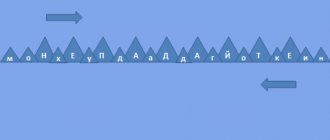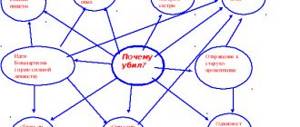Presentation for a literature lesson (grade 11) on the topic: Balmont - presentation
Balmont Konstantin Dmitrievich ( )
“A light, slightly limping gait definitely throws Balmont forward into space. Or rather, it’s as if Balmont falls from the spaces onto the ground into the salon, onto the street. And the impulse breaks within him, and he, realizing that he was in the wrong place... puts on his pince-nez and looks around arrogantly (or rather, fearfully), raises his dry lips, framed by a beard red as fire... And that’s why his whole appearance doubles. Arrogance and powerlessness, greatness and lethargy, boldness, fear - all this alternates in him, and what a subtle whimsical gamut runs through his emaciated face, pale, with widely flared nostrils!... the vengeful genius of a thunderstorm, the demon of burning passion... the red-bearded Thor himself, but Thor wandering sadly along the Arbat on an October day, when streams of rain stretch over the city day and night. He stops... and suddenly arrogantly stamps his foot on the wet asphalt: “I came into this world to see the sun!” This is how Andrei Bely captured the poet’s appearance.
Balmont Konstantin Dmitrievich - symbolist poet, translator, essayist, one of the most prominent representatives of Russian poetry of the Silver Age. Born in 1867 into a noble family in the Vladimir province. Ancestors come from Scandinavia; grandfather was a naval officer, father was the chairman of the zemstvo government in Shuya. Mother from the literary Lebedev family.
Shuya. Balmont family house
K.D. Balmont studied at the Shuya gymnasium, from where he was expelled for belonging to an illegal circle, and completed the course at the Vladimir gymnasium. The inscription on the memorial plaque reads: “Here from 1876 to 1884. The famous Russian poet K.D. studied at the men's classical gymnasium. Balmont." Now this is secondary school 2. It bears the name of the poet.
In 1886 he entered the Faculty of Law at Moscow University, but already in 1887 he was expelled for participating in student riots. Accepted again in 1888, he soon left the university due to a severe nervous breakdown, which ended a year later with him jumping out of a 3rd floor window. The resulting fractures led to “a year of lying in bed,” but at the same time, in his own words, “an unprecedented flowering of mental excitement and cheerfulness.”
With the help of Moscow friends, I began to receive orders for translations. He became close to V.G. Korolenko, who supported Balmont at the beginning of his literary career. In 1899 he was elected a member of the Society of Lovers of Russian Literature. Among Balmont’s first books were the collections “In the Boundless” (1895) and “Burning Buildings” published in Moscow. Balmont's relations with the authorities are still tense. In 1901, for the anti-government poem “Little Sultan,” the poet was deprived of the right to reside in capital and university cities for two years.
The end of the 1890s and the beginning of the 1900s was a period of very fruitful poetic work for Balmont. He creates many romantic poems, including openly erotic ones. The collections “Let's Be Like the Sun”, “Only Love” published in Moscow. Seven Flowers" (1903), "Liturgy of Beauty" (1905) and "Mountain Peaks" (essay, 1904) brought Balmont fame. From 1907 to 1914, Balmont’s “Complete Collection of Poems” was published in ten volumes.
In the early 1900s he spent time in Italy, Spain, England and France; at the end of 1904 he took a trip to Mexico. In 1905 he returned to Russia. The poet's participation in political life continues. In December 1905, Balmont, as he later wrote, “took some part in the armed uprising of Moscow, mostly in poetry.” Around 1906 he wrote the famous poem “Our Tsar”, dedicated to Nicholas II. The poet becomes close to Maxim Gorky, collaborates with the social-democratic newspaper “New Life” and with the magazine “Red Banner” published by A.V. Amphitheater. At the very end of 1905, Balmont illegally left Russia and came to Paris. In the subsequent period, he travels a lot and writes travel essays. In 1913, political emigrants on the occasion of the 300th anniversary of the House of Romanov were granted an amnesty, and on May 5, 1913 Balmont returned to Moscow. He welcomes the February Revolution, and then categorically rejects the October Revolution. Due to his rejection of the new government, he left Russia in June 1920, traveling through Estonia to Germany. Settled in France. The poet spent the last 20 years of his life in exile, suffering from mental illness and poverty. In 1927 he made a lecture tour of Poland (Warsaw, Bialystok, Lodz, Vilna, Grodno, Lvov, Krakow, Poznan) and Czechoslovakia. He performed in Bulgaria. In the summer of 1930 he made a trip to Lithuania.
While in exile, he actively collaborated in the newspaper Latest News, the magazine Sovremennye Zapiski, and in numerous Russian periodicals published in Bulgaria, Germany, Latvia, Lithuania, Poland, Czechoslovakia, and Estonia. Published a book of memoirs “Where is my home?” (Prague, 1924), wrote documentary essays “Torch in the Night” and “White Dream” about his experiences in the winter of 1919 in revolutionary Russia. Publishes in different countries books of poems “Gift to the Earth”, “Bright Hour” (1921), “Haze”, “Song of the Working Hammer” (1922), “Mine to Her. Poems about Russia" (1923), "In the widening distance" (1929), "Northern Lights" (1933), "Blue Horseshoe", "Light Service" (1937). In 1923 he published books of autobiographical prose “Under the New Sickle” and “Air Route”. In 1930 he published a translation of “The Tale of Igor’s Campaign.”
Book cover: Poems Book cover: Lyrics
The range of foreign language literatures and authors that Balmont translated is extremely wide. In his work he was mainly engaged in translations of Western European poets. After a trip to the Scandinavian countries (1892), his passion for Scandinavia was reflected in the translations of Georg Brandes and Henrik Ibsen. He published in seven editions the works of P. B. Shelley in his translation with an introductory article, in 1895 two books of translations from Poe. He translated Spanish poets and playwrights, English poets, prose writers, Polish and Czech writers, the Georgian epic poem “The Knight in the Skin of a Tiger” by Shota Rustaveli, Lithuanian folk songs, poems by Charles Baudelaire. After visiting Japan in 1916, he translated tanka and haiku by various Japanese authors, from ancient to modern.
K.D. Balmont, E.K. Tsvetkovskaya, Mirra Balmont with family I.S. Shmeleva e.

